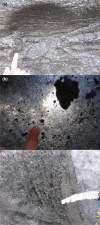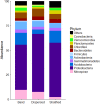Active microbial ecosystem in glacier basal ice fuelled by iron and silicate comminution-derived hydrogen
- PMID: 34459543
- PMCID: PMC8289488
- DOI: 10.1002/mbo3.1200
Active microbial ecosystem in glacier basal ice fuelled by iron and silicate comminution-derived hydrogen
Abstract
The basal zone of glaciers is characterized by physicochemical properties that are distinct from firnified ice due to strong interactions with underlying substrate and bedrock. Basal ice (BI) ecology and the roles that the microbiota play in biogeochemical cycling, weathering, and proglacial soil formation remain poorly described. We report on basal ice geochemistry, bacterial diversity (16S rRNA gene phylogeny), and inferred ecological roles at three temperate Icelandic glaciers. We sampled three physically distinct basal ice facies (stratified, dispersed, and debris bands) and found facies dependent on biological similarities and differences; basal ice character is therefore an important sampling consideration in future studies. Based on a high abundance of silicates and Fe-containing minerals and, compared to earlier BI literature, total C was detected that could sustain the basal ice ecosystem. It was hypothesized that C-fixing chemolithotrophic bacteria, especially Fe-oxidisers and hydrogenotrophs, mutualistically support associated heterotrophic communities. Basal ice-derived rRNA gene sequences corresponding to genera known to harbor hydrogenotrophic methanogens suggest that silicate comminution-derived hydrogen can also be utilized for methanogenesis. PICRUSt-predicted metabolism suggests that methane metabolism and C-fixation pathways could be highly relevant in BI, indicating the importance of these metabolic routes. The nutrients and microbial communities release from melting basal ice may play an important role in promoting pioneering communities establishment and soil development in deglaciating forelands.
Keywords: cryosphere; environmental microbiology; extremophiles; glaciers; microbial ecology.
© 2021 The Authors. MicrobiologyOpen published by John Wiley & Sons Ltd.
Conflict of interest statement
None declared.
Figures







Similar articles
-
Comparison of microbial community compositions of two subglacial environments reveals a possible role for microbes in chemical weathering processes.Appl Environ Microbiol. 2005 Nov;71(11):6986-97. doi: 10.1128/AEM.71.11.6986-6997.2005. Appl Environ Microbiol. 2005. PMID: 16269734 Free PMC article.
-
Culturable bacteria in subglacial sediments and ice from two Southern Hemisphere glaciers.Microb Ecol. 2004 May;47(4):329-40. doi: 10.1007/s00248-003-1036-5. Epub 2004 Mar 4. Microb Ecol. 2004. PMID: 14994176
-
Metagenomic analysis of basal ice from an Alaskan glacier.Microbiome. 2018 Jul 5;6(1):123. doi: 10.1186/s40168-018-0505-5. Microbiome. 2018. PMID: 29976249 Free PMC article.
-
Microbial ecology of mountain glacier ecosystems: biodiversity, ecological connections and implications of a warming climate.Environ Microbiol. 2017 Aug;19(8):2935-2948. doi: 10.1111/1462-2920.13766. Epub 2017 May 30. Environ Microbiol. 2017. PMID: 28419666 Review.
-
Subglacial Lake Whillans microbial biogeochemistry: a synthesis of current knowledge.Philos Trans A Math Phys Eng Sci. 2016 Jan 28;374(2059):20140290. doi: 10.1098/rsta.2014.0290. Philos Trans A Math Phys Eng Sci. 2016. PMID: 26667908 Review.
Cited by
-
Following the flow-Microbial ecology in surface- and groundwaters in the glacial forefield of a rapidly retreating glacier in Iceland.Environ Microbiol. 2022 Dec;24(12):5840-5858. doi: 10.1111/1462-2920.16104. Epub 2022 Jul 13. Environ Microbiol. 2022. PMID: 35706139 Free PMC article.
-
Seasonality in land-ocean connectivity and local processes control sediment bacterial community structure and function in a High Arctic tidal flat.FEMS Microbiol Ecol. 2024 Jan 16;100(1):fiad162. doi: 10.1093/femsec/fiad162. FEMS Microbiol Ecol. 2024. PMID: 38111220 Free PMC article.
References
-
- Anesio, A. M. , Hodson, A. J. , Fritz, A. , Psenner, R. , & Sattler, B. (2009). High microbial activity on glaciers: Importance to the global carbon cycle. Global Change Biology, 15, 955–960. 10.1111/j.1365-2486.2008.01758.x - DOI
Publication types
MeSH terms
Substances
LinkOut - more resources
Full Text Sources
Medical

